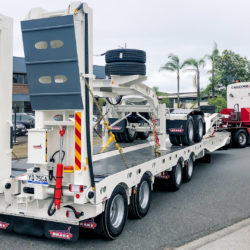In Part One of our look into the uptake of the Performance-Based Standards initiative, we looked at how the PBS is structured and how it is offering potential benefits to drivers, owners and the environment.
In this segment, we will look at the findings presented by the National Heavy Vehicle Regulator (NHVR) at the Australian Road Transport Suppliers Association (ARTSA) Global Leaders’ Summit held in May 2018.
Strong start
ARTSA chair Dr Peter Hart initially offered attendees the opinion that with “over 6,000 PBS-approved combinations now on the road, the scale and penetration of the high productivity scheme is driving greater productivity and safety gains throughout Australia.”
NHVR CEO Sal Petroccitto was on hand to present the report, which initially looked at the origins of the PBS and what it could offer to the industry at large.
Impressively, Petroccitto led with the statistic that 17 per cent of newly-made heavy vehicles in the country come onto the road already PBS-compliant. This is a marked improvement over previous years and goes to show that heavy transport manufacturers can easily make their vehicles ready for the PBS before they go on sale.
New applications on the rise
Over 7,000 trailer combination applications for PBS approval have been granted since the scheme began, and that number is growing exponentially every year since 2011. There were over 1,400 of these approvals alone in 2017, compared to only 450 only five years prior. 2018 looks set to exceed that number again with almost 600 trailer combinations approved for road use in the first four months of the year alone.
Truck and dog trailers are the largest share of all PBS-approved combinations, with a massive 55 per cent of the combinations seen. Data also showed that PBS fleets tend to be younger than others, being on average 3.6 years old compared to a regular heavy haulage fleet of 12.2 years. In the past decade, 60 trailer heavy equipment trailer manufacturers and 22 truck manufacturers have built a PBS-approved unit. This information shows that the PBS is making significant reach into the market.
Outreach and safety
NHVR Chief Engineer Les Bruzsa added that the next challenge was getting PBS integration into different vehicle classes. He said that this is made easier by the way the Australian guidelines are framed around heavy vehicle performance, instead of arbitrary measures of vehicle weights and dimensions as seen in similar systems used in other countries.
There are many positive outcomes of PBS uptake increasing, with driver safety being a primary one. Sal Petroccitto stated that the PBS has led to there being 46 per cent fewer crashes on the roads than conventional vehicles between 2014 and 2017. By basing the scheme on a set of safety standards, the PBS ensures road safety while providing productivity benefits for drivers and operators.
In fact, there were 320 million truck kilometres saved between 2014 and 2017 through the PBS which not only reduced driver risk but also saves on the environment and road wear. This has clear benefits to not only the heavy transport industry but the larger community it serves.
The next challenge for the NHVR is to make taking part in the PBS easier than ever before, with reduced administrative overhead and increased industry outreach to demonstrate the key advantages of the scheme.
Drake Trailers has been a proud supporter of the PBS for many years and works with the scheme to stay on top of the latest requirement changes. Contact The Drake Group to find out how we can get your next trailer PBS-compliant.



